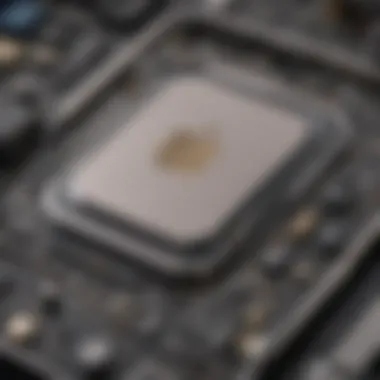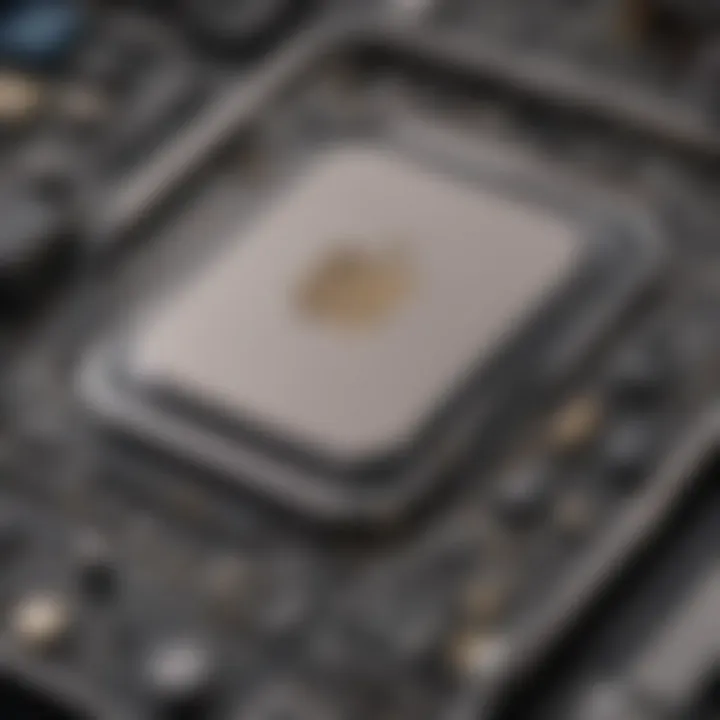In-Depth Look at the iPhone SE Processor Performance


Intro
In the rapidly evolving landscape of smartphones, a device's processor often serves as its heart, guiding its performance capabilities and user experience. This discussion revolves around the iPhone SE processor, emphasizing its significance within Apple's lineup. The iPhone SE has made its mark for its functional design and affordability, but its hidden strength lies within its powerful processor. This article provides crucial insights into the engine driving this device, particularly juxtaposed with other contemporary models by Apple.
Product Overview
The iPhone SE, reinvigorated with contemporary features, seamlessly aligns with Apple’s tradition of delivering high-performance devices in compact forms. Like its predecessor, the second generation of iPhone SE attracts users with its blend of performance and price.
Key Features and Specifications
The iPhone SE is notably powered by the A13 Bionic chip, which debuted with the iPhone 11 series. Here are some crucial specifications:
- CPU: A13 Bionic chip with a 6-core CPU
- GPU: 4-core GPU for advanced graphics performance
- RAM: 3 GB
- Storage Options: 64 GB, 128 GB, and 256 GB
These components underscore the device's capability to handle heavy-duty tasks effortlessly, catering not only to everyday users but also hands-on tech enthusiasts.
Comparison with Previous Models
When comparing the iPhone SE with its predecessor, the first-generation SE, the performance leap is substantial. The A9 processor in the original can hardly withstand the raw power of the A13. It provides enhanced speed and efficiency, which leads to remarkable multitasking capabilities and a smoother overall experience.
Performance and User Experience
Several aspects define user experience and perk up device performance well beyond expectations one might anticipate relating to entry-level smartphones.
Performance Analysis
The A13 Bionic chip delivers extraordinary value with its efficient encoding and decoding abilities, playing a critical role in retaining battery life while showcasing excellent performance. Users frequently unlock their devices in the midst of numerous apps, all running smoothly without lag. Battery life, on the other hand, presents longevity ideal for regular use, bypassing many worries for battery-challenged devices.
User Interface and Ease of Use
The iPhone SE marries the ease of Apple's iOS interface with the nuances of its processing power. Navigating through spontaneous changes in applications feels flawless and responsive, due to architecture optimally designed for performance cohesion.
User Experience Feedback and Opinions
User opinions commonly highlight speed and responsiveness while handling multimedia. Apps load swiftly. Gaming is generally applauded for reduced downtime in graphics-intensive tasks. Furthermore, its capacity to comfortably support iOS updates promises sustainability within the Apple ecosystem.
Design and Build Quality
The exterior makeup of the iPhone SE embraces a specific charm rooted in simplicity and familiarity.
Design Elements and Aesthetics
Encased you'll find aluminum and glass materials which provide a modern aesthetic while accentuating durability. The compact size makes it easy for many users to handle in various environments.
Durability and Build Quality Assessments
Its build quality has received favorable reviews, as evidence shows that most experiences notwithstanding casual drops deliver few consequences. Furthermore, the inexpensive repair options associated with cracked screens are considerations for consumers leaning towards such devices.
Software and Updates
Software framework entailed in each device can influence longevity and alignment over time with expected technological advances.
Operating System Features and Updates
Running iOS simplifies various software updates while continually enriching user experiences. Substantially compatible with ongoing app inventories specializes in presenting a seamless transition across upgrades.
App Compatibility and Availability
App store documentation clinches strong compatibility with many available apps ensuring user accessibility while maintaining device relevance. Streaming multimedia services like Netflix and productivity apps run unencumbered.
User Customization Options
Although the iPhone SE is not the aspirational model for marginal customizations, merely switching wallpapers or applying type themes typically fulfills personalization desires for average iOS users.
Price and Value Proposition
Retail prices of devices often veer perceptions on product accessibility appearances.


Price Point and Variants Available
The iPhone SE holds a competitive price spectrum, beginning around 399 U.S. dollars for the base model. Compared with sprawling dimensions of larger choices among Apple's smartphones, SE competes credibly against powerful industry's contemporaries aimed at budget-focused customers.
Value for Money Assessment
Given the caliber of components integrated with the price point, it arguably renders robust value particularly to users well-versed or interested in functionality beyond trends.
Prolusion to the iPhone SE
Understanding the iPhone SE is essential. It is not just another device; it is a representation of Apple's focused approach to volume and performance. The iPhone SE reflects a unique segment in Apple's lineup—a device aimed at those who desire an affordable smartphone without compromising on technology. The relationship between the processor and overall user experience is crucial. It shapes how users interact with apps, navigate the device, and expect performance over time. Knowing the iPhone SE can provide insights into Apple's market strategy and long-term vision.
Overview of the iPhone SE
The iPhone SE was first introduced in 2016, fitting into the relatively compact device category. It often appeals to users looking for high specs in a smaller shell. The importance of this device lies in its affordability paired with advanced technology. With a design that resembles older models, it carries typical iPhone qualities such as build quality and interface usability. Features like similar camera specs and touch ID technology bridge the gap between older iPhones and more recent models—appealing to various users.
Generational Context
Generational context is a key lens through which to view the iPhone SE. It serves as a midpoint in Apple’s generational line. Introduced after the iPhone 6S series but alongside new iterations like the iPhone 7, it shows how Apple continues to balance space in the market dynamic. The iPhone SE occupies a unique space where classic design meets modern internals.
- Historical significance: The first-generation SE filled the void after the original iPhone 5 and 5S.
- Integration of technologies: It inherits features from previous generations and introduces optimized elements from flagship models.
- Competitive landscape: It serves as a strategic response to increasing competition in the mid-range smartphone space, catering to users who seek quality without top-tier pricing.
In a broader sense, it fits Apple's ongoing narrative—to provide a range of products that leverage powerful processors without diluting the core iPhone experience.
The Processor of the iPhone SE
The processor of the iPhone SE plays a crucial role in the smartphone's overall performance and user experience. It integrates core functionalities, which make the device responsive and capable of multi-functional tasks. Understanding its intricacies allows users to appreciate how Apple optimizes hardware and software performance in an economically priced product. This processor not only supports everyday applications but also elevates gaming and graphics-intensive usage, aligning with Apple's commitment to quality and efficiency.
Identification of the Processor
The heart of the iPhone SE lies within the A15 Bionic chip. This processor has made its presence felt in several other Apple devices, showcasing consistent innovation across the brand. It's imperative to recognize that Apple designs its chips, resulting in optimized performance tailored for iOS. The blending of hardware and software is evident with the A15, making it a strong contender among its peers.
Technical Specifications
Architecture
The A15 Bionic utilizes a 5-nanometer architecture, which is significant for its compact design allowing for improved efficiency and performance. The smaller fabrication size enables increased transistor density, translating into higher computational power without compromising thermal management. This is a beneficial choice, as
- It supports a 6-core CPU that enhances multitasking capabilities.
- Advanced neural engines provide efficient processing for machine learning tasks.
One unique feature of this architecture is how it operates with optimization for high power-performance balance, minimizing lag during heavy loads.
Core Count
The A15 integrates a total of six processing cores: two high-performance cores and four efficiency cores. This core count is vital as it provides flexibility under load conditions. Given how typical usage varies, the distinct core setups allow for autoscaling performance depending on requirements.
- High-performance cores manage demanding tasks efficiently.
- The efficiency cores handle simpler processes, conserving battery life.
What sets this core configuration apart is its dynamic architecture, allowing smooth transitions between high and low power uses, promoting battery sustainability.
Clock Speed
Clock speed expertise is another cornerstone in the A15’s design, with the performance cores clocking up to 3.1 GHz. The significance here relies not just on speed but also on consistency during use.
- High clock speeds ensure that intensive apps and processes run without hiccups.
- Significant responsiveness in real-world applications boosts user experiences.
One aspect that merits attention is that while clock speed enhances performance, it is not the only determinant of how well a chip runs. Efficient architecture coupled with scalable designs solidifies the A15's overall advantage.
The performance of the A15 Bionic lies in its capabilities across varied applications—from day-to-day tasks to high-end mobile gaming, exhibiting Apple's strategic prowess in chip design.
Performance Metrics
Performance metrics are essential in evaluating the processor's capabilities in the iPhone SE. Understanding performance metrics allows users to gauge the efficiency and responsiveness of their devices. Measurements that indicate how well the processor performs can greatly impact user experience.
Benchmark Comparisons
Single-Core Performance


Single-core performance refers to the efficiency of a single central processing unit (CPU) core while executing tasks. This aspect is vital in determining how the processor handles everyday tasks such as browsing, messaging, and app usage.
The key characteristic of single-core performance lies in its ability to manage tasks that do not require multiple cores for execution. High single-core performance can enhance responsiveness, resulting in smoother transitions and quicker app launches. For users who prioritize simple tasks over complex processing, this is a beneficial trait.
One unique feature of single-core performance in the iPhone SE is its optimized architecture. Apple designs CPU cores to work exceptionally well with operating system functions. As a result, basic activities can be handled with notable efficiency. However, while high single-core performance is advantageous, it may lead to underutilization during multi-threaded applications.
Multi-Core Performance
Multi-core performance assesses how well a processor handles multiple tasks simultaneously. This factor is increasingly important in a multitasking environment. As apps become more demanding and tasks more complex, multi-core capability becomes essential.
The notable characteristic of multi-core performance is its contribution to running resource-intensive applications. Programs that require significant processing power, like video editing or graphics rendering, benefit immensely from multiple cores working in tandem. This efficiency leads to enhancements in overall speed and functionality.
The unique feature in the iPhone SE’s multi-core architecture is its balance. This balance allows the device to engage multiple cores without causing unnecessary power drain. However, the disadvantage lies in cases where the software is not optimized for multi-threading. The performance difference might not meet the users’ expectations in certain scenarios.
Real-World Usage Analysis
App Performance
App performance reflects how smoothly applications run on a device. In the context of the iPhone SE, the processor's strength allows apps to execute tasks quickly. App performance also relies on initial load times and functioning during usage.
One main characteristic defining app performance in the iPhone SE is efficiency in launching apps. Users experience minimal lag, which is crucial for daily, habitual usage. Furthermore, the processor's architecture ensures that even demanding apps maintain functionality.
However, while iPhone SE supports a variety of apps, not all will run smoothly, especially if heavily reliant on multi-core function without optimization. Third-party apps may need time to adapt fully.
Gaming Experience
Gaming experience pertains to how well a device plays mobile games. High-quality graphics and fast-paced gameplay are determinants for gamers. For the iPhone SE, the processor is capable in delivering satisfactory performance across a range of gaming applications.
The key characteristic defining the gaming experience is the ability to maintain high frame rates even in graphically-intensive titles. This keeps the gameplay enjoyable and reduces instances of stuttering. Moreover, the gaming experience leverages the efficiency and power of the iPhone SE’s processing architecture, which manages graphic demands well.
Nevertheless, limitations may arise when it comes to extraordinarily complex games that push hardware to limits. Users may note fluctuations in performance, especially in extremely high-demand scenarios, like heavy multiplayer gaming.
The importance of performance metrics cannot be overstated; they gauge how seamlessly the processor can operate tasks and sustain the user’s experience.
Comparative Analysis with Other Apple Processors
Comparing the processor of the iPhone SE with other Apple processors holds significant value in understanding its performance and capabilities. The key differentiators and functionalities can illuminate how the iPhone SE fits into Apple's ecosystem, particularly regarding its utility for users.
Comparison with A-series Processors
The iPhone SE utilizes Apple's A-series processor, specifically the A13 Bionic chip. The A13 is central in defining the capabilities of the iPhone SE in relation to other devices. It's essential to view this comparison through dimensions such as performance benchmarks and user experience satisfaction.
- Performance: The iPhone SE not only matches but can outperform some models, owing to its optimized processing power relative to its price. This places the A13 among the higher-tier A-series processors, making it suitable for both power users and everyday consumers.
- Price-Performance Ratio: Apple's strategy often focuses on delivering performance excellence without overwhelming costs for consumers. The affordable nature of the iPhone SE coupled with a high-performance processor makes it an intriguing competitor in the mid-range smartphone market.
Positioning within the Apple Ecosystem
Discussing the positioning of the iPhone SE within the Apple ecosystem gives insight into both design and marketing perspectives. It shows how the iPhone SE serves distinct segments of the market while complementing existing offerings from Apple.
iPhone Models
In the seasonal cadence of iPhone releases, the SE line has introduced affordability, attracting consumers who may not seek the latest flagship.
- Key Characteristic: Essential features like the compact size and high camera quality significantly appeal to a younger audience or users who prefer smaller devices. Hence, the iPhone SE becomes a smart investment that doesn't skimp on essential functionalities.
- Unique Feature: The integration of the A13 Bionic processor enables similar computational capabilities to more expensive models while remaining economical. This accessibility has aided in its rapid acquisition among budget-conscious consumers, ensuring a steadfast spot in sales rankings.
iPad Models
Examining how the SE interacts with Apple’s iPad family adds context to understanding imediate needs versus larger applications.
- Key Characteristic: By pivoting towards user-friendly features, iPads appeal to those needing robust features on larger screens while contributing to fluid multitasking.
- Unique Feature: The A13 Bionic processor ensures compatibility with demanding apps, reflecting ambition across the iOS lineup. This versatility invariably enhances the overall processing interaction within the Apple ecosystem, aligning iPhone performance closer to that of the iPad and benefiting interpreters of macOS functionally and coherently.
An optimized processor not only drives power but sew the aspirations of accessibility into the hands of everyday users.
Architectural Innovations
Architectural innovations play a crucial role in understanding the efficacy and advancement of the processor within the iPhone SE. It reflects the thoughtful design philosophy instituted by Apple, emphasizing not only performance but also user experience and efficiency. The processor’s architecture integrates various technological innovations that enhance capabilities, catering to both everyday users and power users.
Neural Processing Capabilities


The iPhone SE incorporates specific neural processing features that are designed to improve tasks involving machine learning and augmented reality. This processors architectural aspects incorporate a dedicated Neural Engine, which allows it to efficiently handle advanced tasks without degrading the overall system performance.
- This allows for seamless image recognition, enhancing photography features by automatically adjusting settings for optimal results.
- The always-on functionality ensures that voice assistants can function effectively, listening for commands without noticeable delays.
The implications of these neural processing capabilities extend beyond just enhancing user functionality; they also signify a substantial leap in how mobile devices integrate artificial intelligence. The focus on AI reflects industry trends that advocate for smart assistance and automation in daily routines.
Energy Efficiency Considerations
Another pivotal aspect of the processor's architecture is its emphasis on energy efficiency. The iPhone SE manages its power consumption effectively through a combination of software and hardware integration. Clever use of architecture minimizes battery drain while maximizing performance.
- The processor utilizes advanced fabrication techniques, making it a compelling option for users concerned with prolonged battery life.
- Intelligent performance scaling impacts how applications run and respond, determining when the processor needs to shift gears when under load.
The architectue designs leads to longer periods between charges, permitting users to better enjoy media and applications without the anxiety often tied to battery management. Battery life in mobile devices is frequently cited as a significant factor for user satisfaction, signifying the importance of energy efficiency in modern processors.
The architectural innovations of the iPhone SE’s processor encapsulate a blend of performance, efficiency, and smart functionality, delineating Apple's strategic focus on enhancing user experience.
Impacts on User Experience
The impacts of the iPhone SE’s processor on user experience cannot be overstated. The processor plays a crucial role in determining how smoothly the device operates and how effectively it can run various applications. Improved software performance, security capabilities, and battery efficiency create a symbiotic relationship between hardware and user satisfaction.
Impact on Software Performance
The processor significantly influences software performance on the iPhone SE. It allows applications to load more quickly, run faster, and respond instantly to user interactions. An optimized processor enhances mobile computing capabilities, whether users are multitasking across different apps or running more demanding applications like video editing tools.
Another noteworthy point is the seamless integration of the iPhone SE's processor with iOS. This tight integration ensures that the system is fine-tuned for software, providing a more distinctly tailored user experience. Users notice this in faster browsing, improved gaming graphics, and general system responsiveness. Essentially, the varied tasks perform near a flawless execution.
The processor within the iPhone SE infuses a more dynamic software experience, demonstrating how hardware and software synergy enhances usability.
Influence on Battery Life
The efficiency of the iPhone SE’s processor directly affects battery life, which is a significant consideration for modern smartphone users. An energy-efficient processor helps the device use less power while managing tasks. This translates to increased screen time, as the battery lasts longer due to optimized energy consumption.
The iPhone SE stands out because it employs advanced power management techniques. Features like adaptive brightness and selective activation of cores allow the device to minimize battery drain, ensuring that it serves users well throughout the day. Consequently, charge cycles are less frequent. Users appreciate this aspect as it decreases their reliance on chargers during daily use.
Ultimately, the balance between performance and longevity underscores the importance of the processor in enhancing the user experience on the iPhone SE. Combining speed and efficiency leads to a more enjoyable everyday experience with fewer interruptions related to battery capacity.
Future Outlook
The consideration of future developments in mobile processors is central to understanding not only the current performance of the iPhone SE but also its capacity to evolve in a rapidly shifting technological landscape. As smartphones surge in capabilities, processor architecture becomes pivotal. Manufacturers, including Apple, continuously refine design and technology to keep pace with user demands for enhanced performance while ensuring power efficiency and longevity.
Potential Upgrades
The iPhone SE has recently shown how effective its processor is within the confines of current technology. Yet, upcoming iterations may bring around significant upgrades. These could be in the form of increased core counts for parallel processing or innovations in manufacturing processes that yield higher performance while keeping thermal output minimal.
Moreover, integrating more advanced neural processing units could improve AI features on the device, bringing about advancements that offer users a more intuitive and seamless experience. Enhanced clock speeds could also offer snappier performance during multitasking, particularly in resource-intensive applications and games.
Some anticipated upgrades include:
- Enhanced neural engines for better machine learning capabilities
- Improved graphics performance through more robust GPU cores
- Advanced energy efficiency for optimized battery life
As these enhancements materialize, future users can expect an iPhone SE that aligns more closely with market trends and user expectations.
Emerging Trends in Mobile Processors
There are significant trends reshaping mobile processors that impact the next generation of devices, including those like the iPhone SE. Among these trends is the shift towards 3nm manufacturing processes, which promise better performance and efficiency. Apple, a standout in embracing cutting-edge technology, is likely to lead further advancements here.
Another noticeable trend is the expansion of AI integration across the mobile spectrum, empowering devices to handle tasks more autonomously and learn from user habits. The emphasis on optimizing energy consumption without compromising performance aligns well with the increasing need for sustainability in tech products.
Moreover, there's the varying competition landscape. As manufacturers pivot towards creating all-encompassing software suites for mobile processors, Apple must stay relevant via innovation.
The End
The conclusion draws together the essential insights covered in this article about the processor of the iPhone SE. Highlighting both the technical specifications and their implications for user experience provides a holistic view. The processor’s robust architecture and optimization lead to superior app performance and gaming experiences, crucial factors for a smartphone user diligence.
Summation of Key Points
The iPhone SE’s processor showcases remarkable performance metrics while emphasizing the integration of modern technology into a compact device. Key points include:
- Processor Identification: Recognition of the processor type and its generations gives context to its capabilities.
- Technical Specifications: Specifications such as Architecture Core Count Clock Speed are intrinsic in understanding how effectively it can manage tasks.
- Performance Metrics: Benchmark comparisons further underline its efficiency in both single-core and multi-core performance.
- Real-World Usage: Practical insights reveal how this processor plays a critical role in everyday applications and gaming scenarios.
- Comparative Analysis: Placing the iPhone SE processor among other Apple processors offers a clear view of its position within the Apple ecosystem.
- Architectural Innovations: Discussion of the neural processing capabilities and energy efficiency helps illuminate future technological advances.
- Future Outlook: Clearly defining the potential upgrades and emerging trends in mobile processors opens avenues for expectations in Apple’s innovation roadmap.
Final Insights
The evolving nature of the iPhone SE’s processing power establishes its importance in both current usage and future technological trends.



